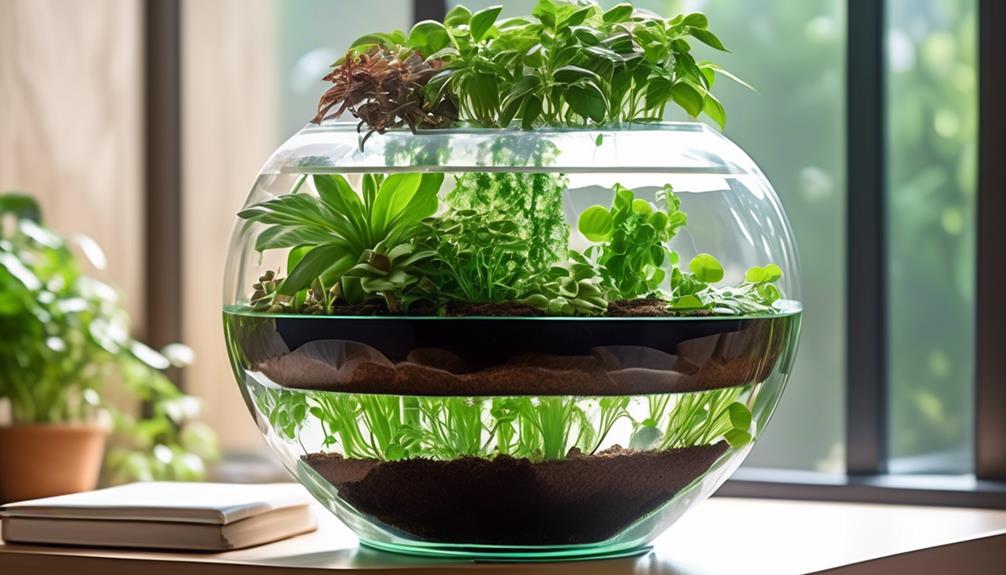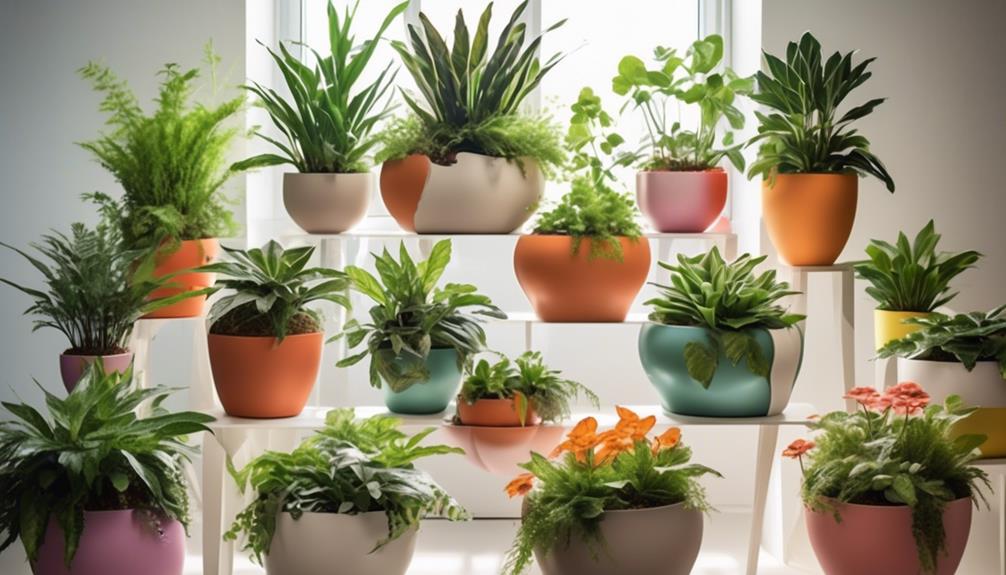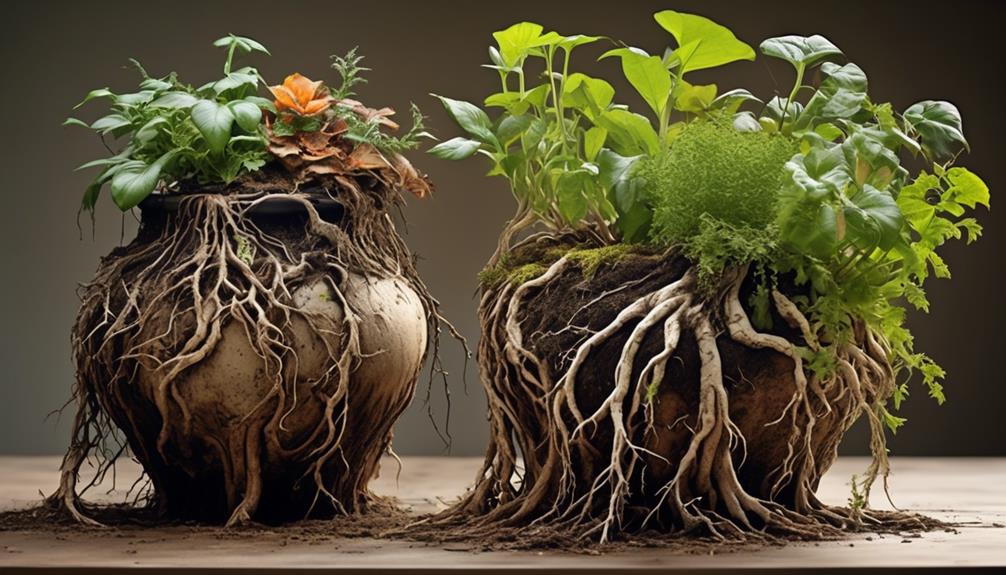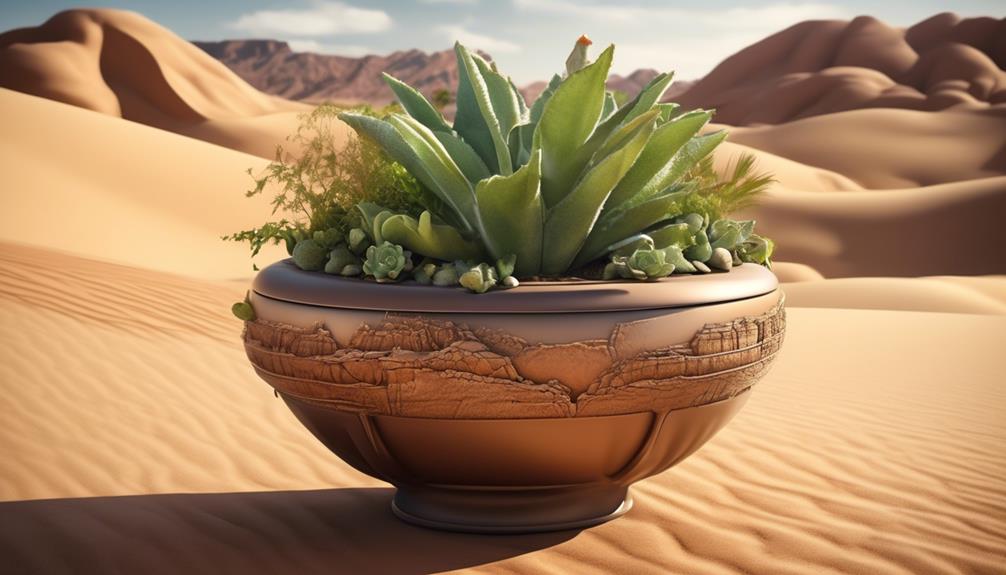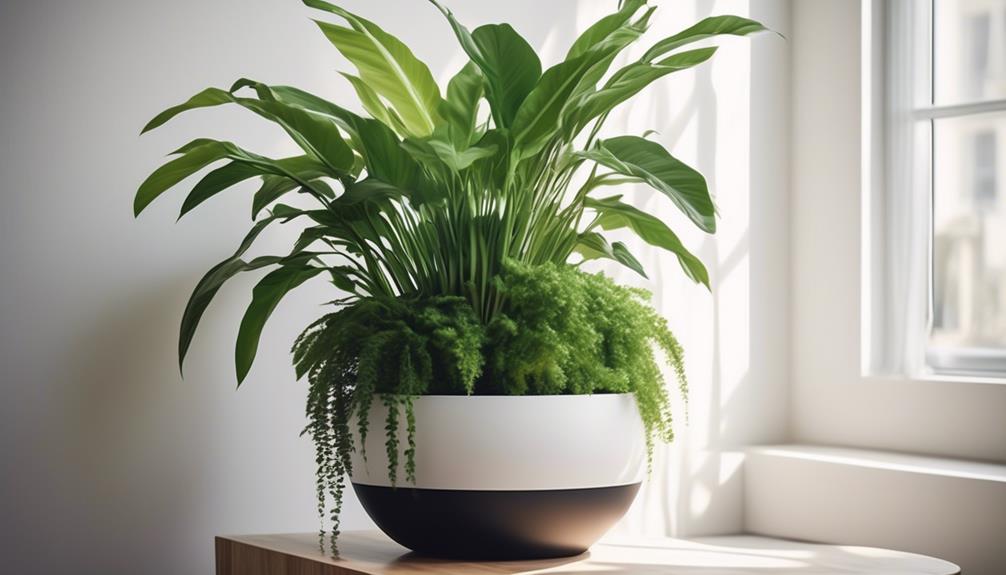We have all encountered this challenging situation: attempting to provide our plants with the perfect amount of water, ensuring we do not over or under-water them. What is the solution? Self-watering planter pots, a modern solution to this age-old problem.
But how exactly do they work? The answer lies in the clever design and innovative technology behind these pots, which I'll be exploring in detail.
Stay tuned to uncover the science and benefits behind self-watering planter pots, and learn how they could revolutionize the way you care for your plants.
Key Takeaways
- Self-watering pots automatically supply water to plants as needed.
- The wicking system's efficiency depends on the material used for the wick.
- The water reservoir holds water that's drawn up into the soil as needed.
- Self-watering pots optimize water usage and promote optimal soil moisture levels.
The Basics of Self-Watering Pots
Self-watering pots automatically supply water to plants as needed, making them a convenient and efficient option for maintaining healthy vegetation.
Understanding the basics of self-watering pots is essential for optimizing plant growth. These pots have a reservoir that holds water, and the soil sits on top of a perforated platform separating it from the water below. Through capillary action, the soil draws up water from the reservoir, ensuring consistent soil moisture. This mechanism helps in regulating the watering frequency, as the plant draws water from the reservoir only when needed.
The design prevents overwatering, which can lead to root rot, and underwatering, which can cause plant stress. By maintaining optimal soil moisture, self-watering pots promote healthier root systems and overall plant growth.
It's important to monitor the water level in the reservoir to ensure a steady supply for the plants. Understanding the dynamics of water movement within the self-watering pot is crucial for effectively utilizing this innovative system to support thriving plant life.
Understanding the Wicking System
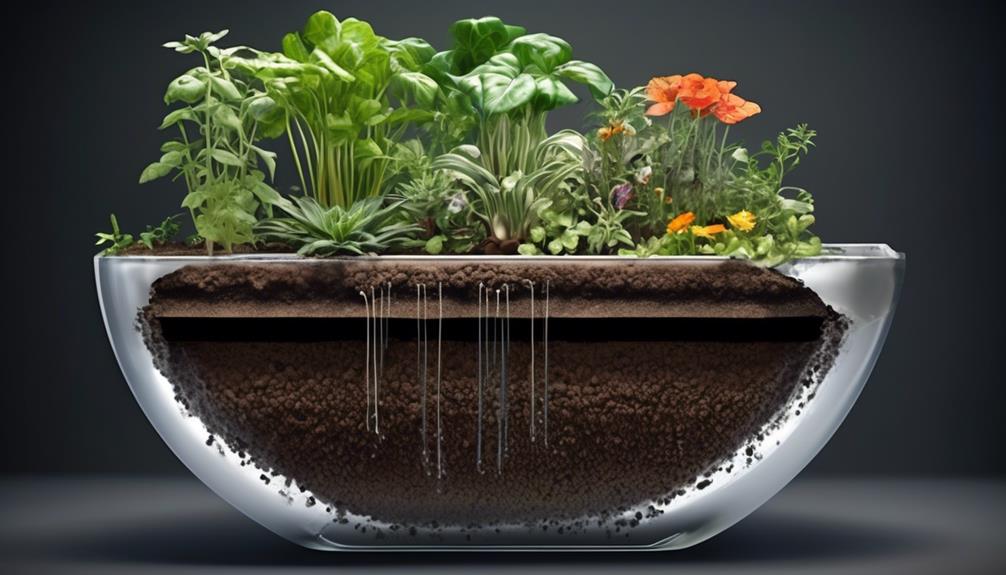
Understanding the wicking system involves comprehending the process by which water moves from the reservoir to the soil, ensuring consistent moisture for plant growth. The wicking process is facilitated by capillary action, where water is drawn upward through the soil and into the root zone. This mechanism relies on the cohesive and adhesive properties of water, allowing it to move against gravity.
The following points provide a deeper understanding of the wicking system:
- Capillary Action: This fundamental concept involves the movement of water within the tiny spaces of a porous material, such as soil or a wick. Capillary action is the driving force behind the wicking process, enabling water to be transported from the reservoir to the soil.
- Water Absorption: The wicking system's efficiency depends on the material used for the wick, as it determines the rate of water absorption. Materials with high capillary action, like cotton or felt, are often employed to ensure optimal moisture distribution.
- Moisture Distribution: Once the water is drawn up through the wick, it disperses into the surrounding soil, maintaining a consistent level of moisture essential for healthy plant growth.
Mastering the wicking system is crucial for maximizing the benefits of self-watering planter pots, ensuring that plants receive the water they need for sustained health and vitality.
Exploring the Water Reservoir
Examining the water reservoir reveals its critical role in providing a consistent water supply to the soil, essential for sustaining plant health and growth. The reservoir, typically located at the bottom of the planter, holds water that's drawn up into the soil as needed. This self-watering system regulates the watering frequency, preventing both overwatering and underwatering, and maintaining optimal moisture levels for the plants.
Reservoir maintenance is crucial for the proper functioning of the self-watering planter. Regularly checking the reservoir for debris, such as dirt or roots, is essential to ensure unimpeded water flow. Additionally, cleaning the reservoir periodically prevents the buildup of algae and mold, which can negatively impact the water quality and, subsequently, the plant's health.
Understanding the watering frequency is vital for the effective utilization of the water reservoir. Factors such as plant type, environmental conditions, and the size of the planter directly influence the rate at which water is drawn from the reservoir. Monitoring the soil moisture and adjusting the reservoir's water level accordingly is key to providing the right amount of water for optimal plant growth.
Benefits of Self-Watering Pots
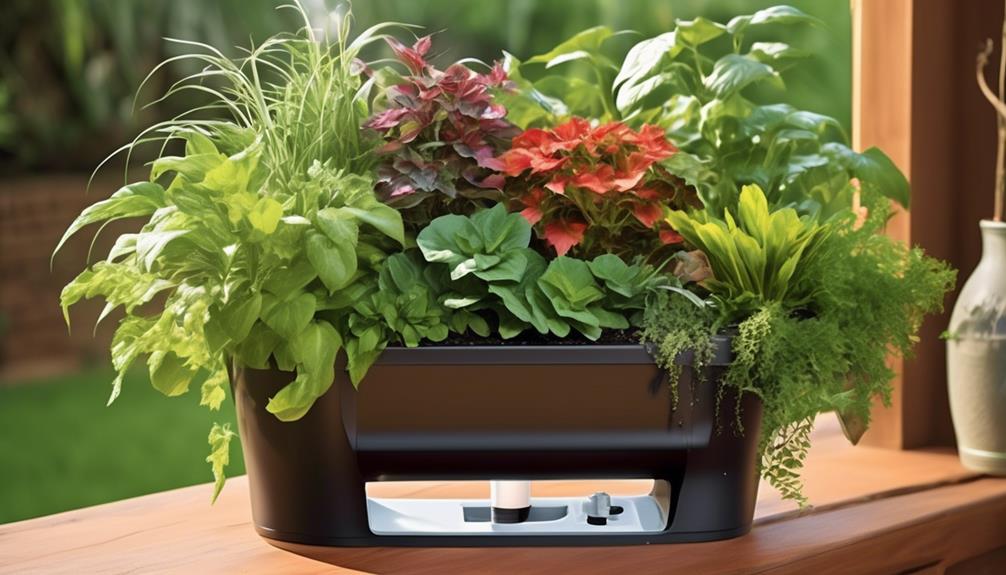
The advantages of utilizing self-watering pots extend beyond simply providing a consistent water supply to the plants. There are several benefits that contribute to the overall health and growth of the plants:
- Watering Efficiency
- Self-watering pots optimize water usage by delivering water directly to the plant's roots as needed, reducing water wastage through evaporation or runoff.
- The water reservoir in self-watering pots prevents overwatering, a common issue in traditional pots, by allowing the plant to draw in water as required, promoting optimal soil moisture levels.
- Plant Health
- Consistent moisture levels provided by self-watering pots support robust root development, which is crucial for overall plant health and growth.
- By preventing water stress, self-watering pots help plants to thrive, leading to healthier foliage, vibrant blooms, and better fruit production.
Choosing the Right Soil
When selecting soil for self-watering pots, we prioritize a composition that complements the watering efficiency of the pots, supporting optimal moisture levels and root development for the plants. The ideal soil composition for self-watering pots should have a balanced mix of organic matter, such as peat moss or coconut coir, to improve water retention and aeration. These components help maintain consistent moisture levels while ensuring that the roots have access to oxygen.
Additionally, adding perlite or vermiculite to the soil mix can further enhance water retention and drainage, preventing waterlogged conditions that can lead to root rot. It's important to avoid using dense, compacted soils that hinder water movement and root growth, as these can impede the self-watering system's effectiveness.
Furthermore, incorporating a slow-release fertilizer into the soil mix can provide essential nutrients to the plants over an extended period. By carefully considering the soil composition, water retention, and nutrient availability, we can maximize the benefits of self-watering pots and create an optimal environment for plant growth.
Filling and Maintaining the Reservoir
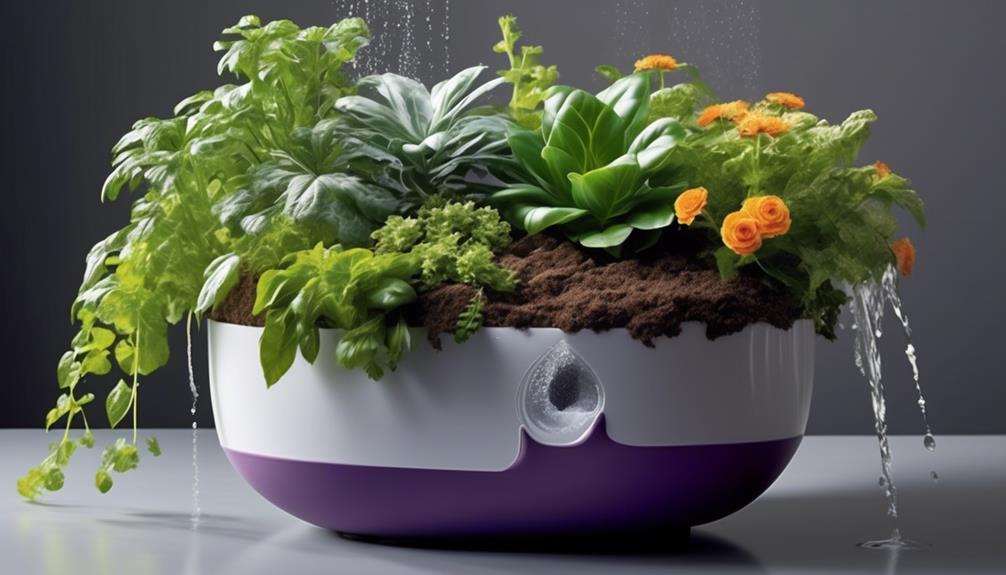
We will now discuss the process of filling and maintaining the reservoir in self-watering planter pots.
- Filling Techniques
- To fill the reservoir, pour water through the designated fill spout until the indicator shows that it's full. This prevents overfilling and ensures optimal water distribution.
- When using the wick system, gently pour water into the soil until the reservoir is full. The wick will absorb the water and distribute it to the plant's roots as needed.
- Water Absorption
- The soil and wick, if present, absorb water from the reservoir through capillary action, ensuring the plant has consistent access to moisture.
- Some self-watering pots have a water gauge to visually indicate the water level in the reservoir, allowing users to monitor and adjust water levels as needed.
- Reservoir Maintenance
- Regularly check the water level in the reservoir to ensure it doesn't run dry, especially during hot weather or when the plant's water needs increase.
- Clean the reservoir periodically to prevent mineral buildup, algae growth, or the development of unpleasant odors that may affect the plant's health.
- Regular maintenance ensures proper water distribution and a healthy growing environment for your plant.
Monitoring Water Levels
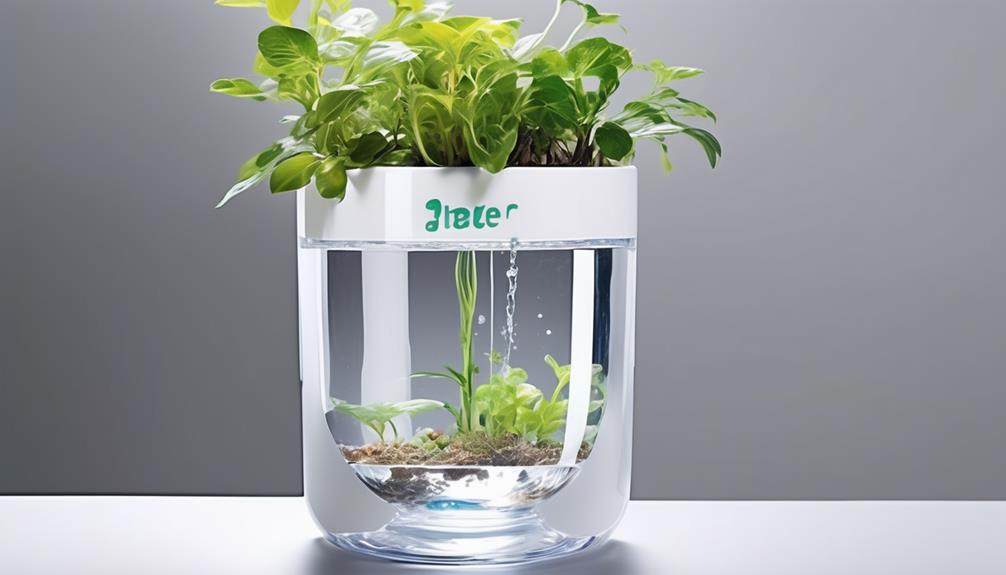
Monitoring water levels in self-watering planter pots involves regularly checking the reservoir to ensure adequate moisture for the plant's needs. It is essential to maintain the optimal moisture levels to support plant growth and prevent overwatering or underwatering. To achieve this, understanding the watering frequency and the correlation between the water reservoir and the plant's moisture requirements is crucial. Here is a table summarizing the key points to consider when monitoring water levels in self-watering planter pots:
| Aspect | Considerations | Actions |
|---|---|---|
| Watering frequency | Check the water levels every few days | Adjust the frequency based on plant needs |
| Optimal moisture levels | Monitor the soil moisture using a probe | Refill the reservoir when needed |
Customizing for Different Plants
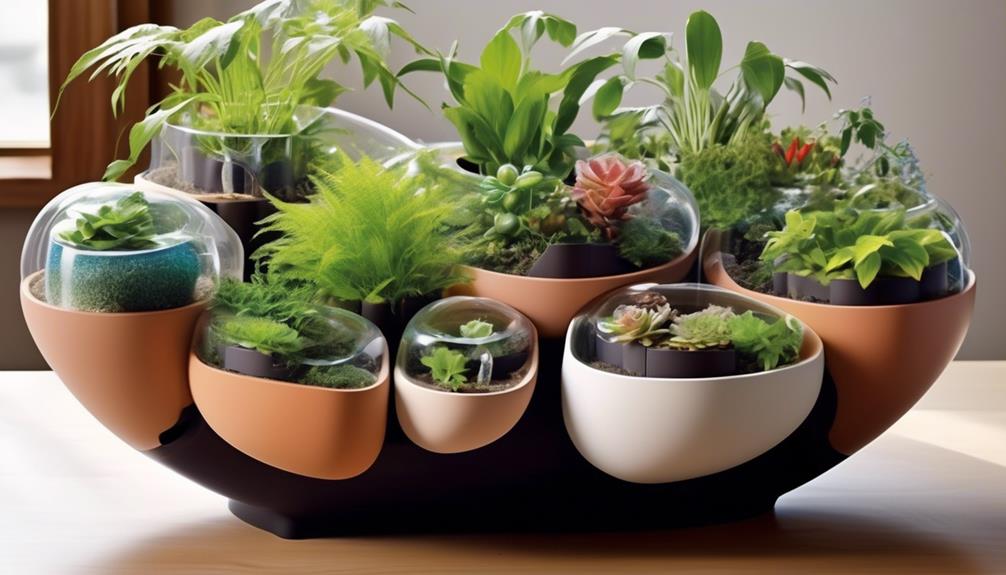
When customizing self-watering planter pots for different plants, it's essential to consider the specific water requirements of each plant. Adjusting the watering mechanisms based on the plant's needs can optimize growth and prevent overwatering or underwatering.
Understanding plant-specific water levels will allow for precise customization of the self-watering system, promoting healthy and thriving plant growth.
Plant-Specific Water Levels
Different plants have varying water requirements, and it's essential to adjust the watering levels to meet the specific needs of each plant species. When customizing watering solutions for different plants, it's crucial to consider the optimal hydration levels for each specific plant type.
This can be achieved through the following:
- Understanding Plant Specific Needs:
- Research the specific hydration requirements of each plant species to determine the ideal watering levels.
- Consider factors such as the plant's native environment, growth stage, and water retention capacity of the soil.
- Implementing Irrigation Systems:
- Utilize self-watering pots with adjustable water reservoirs to tailor the watering frequency and volume to the plant's specific needs.
- Adapting Watering Solutions:
- Adjust the watering schedule and methods based on the plant's individual requirements to ensure optimal hydration levels are consistently maintained.
Adjusting Watering Mechanisms
To tailor the watering frequency and volume to the specific needs of different plant species, implementing irrigation systems such as self-watering pots with adjustable water reservoirs is essential.
Adjusting the watering mechanism involves optimizing moisture levels and controlling the water flow to meet the precise requirements of various plants. For plants that prefer drier conditions, the flow rate can be reduced to limit the water supply, whereas for moisture-loving plants, the flow can be increased to ensure adequate hydration.
Comparing Traditional Watering Methods
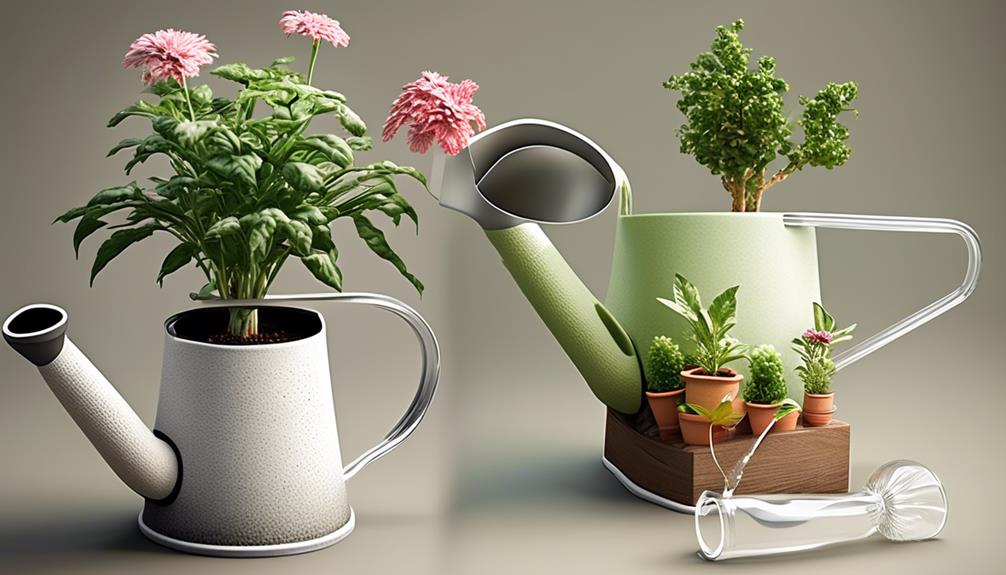
By examining the effectiveness and efficiency of traditional watering methods, we can better understand their impact on plant growth and overall water consumption.
- Watering Frequency
Traditional watering methods often require frequent watering, as much as once a day, to maintain optimal soil moisture levels. The frequency of watering is influenced by various factors such as plant type, soil composition, and environmental conditions. Inconsistent watering frequency can lead to fluctuations in soil moisture, affecting plant health and growth.
- Soil Moisture
Traditional watering methods may result in uneven soil moisture distribution, with surface soil drying out quickly while lower layers remain moist. The manual watering process can lead to overwatering or underwatering, impacting the overall health and development of plants. Inadequate soil moisture management can also lead to nutrient leaching and root damage.
Extending Watering Intervals
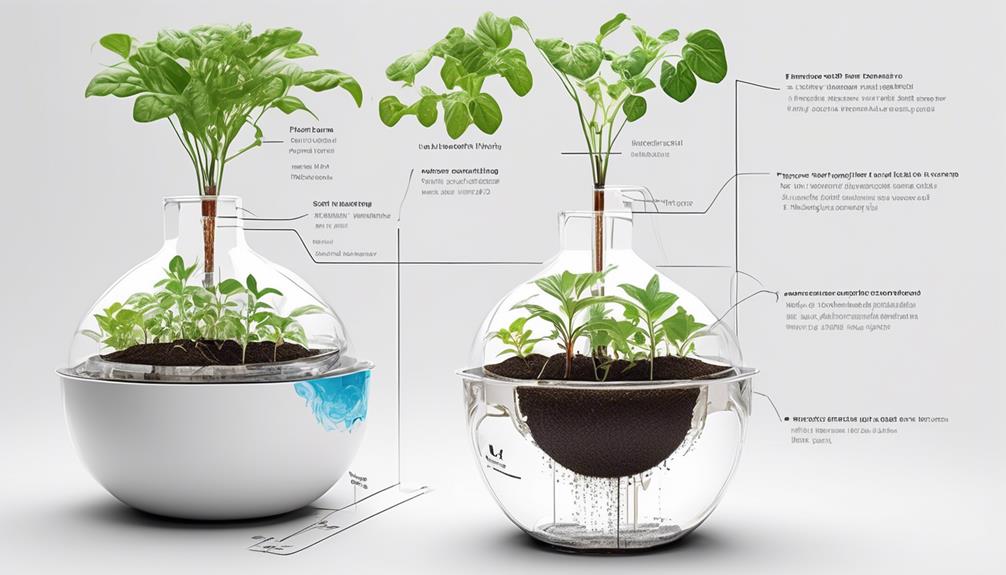
Extending the interval between watering sessions can be achieved through the implementation of self-watering planter pots. These pots utilize a reservoir system to maintain consistent soil moisture levels. By utilizing capillary action, the soil draws water from the reservoir as needed, creating a self-sustaining cycle.
Maximizing efficiency is achieved through the optimization of the reservoir size, pot size, and plant type. This ensures that the water supply matches the specific needs of the plant. This precise control over water delivery reduces water consumption by preventing overwatering and minimizing evaporation.
Additionally, the use of soil moisture sensors can further enhance efficiency. These sensors provide real-time feedback on the moisture levels, allowing for adjustments to be made accordingly.
The design of the pot also plays a crucial role in extending watering intervals. It prevents waterlogging and ensures adequate aeration to the roots.
Addressing Common Concerns
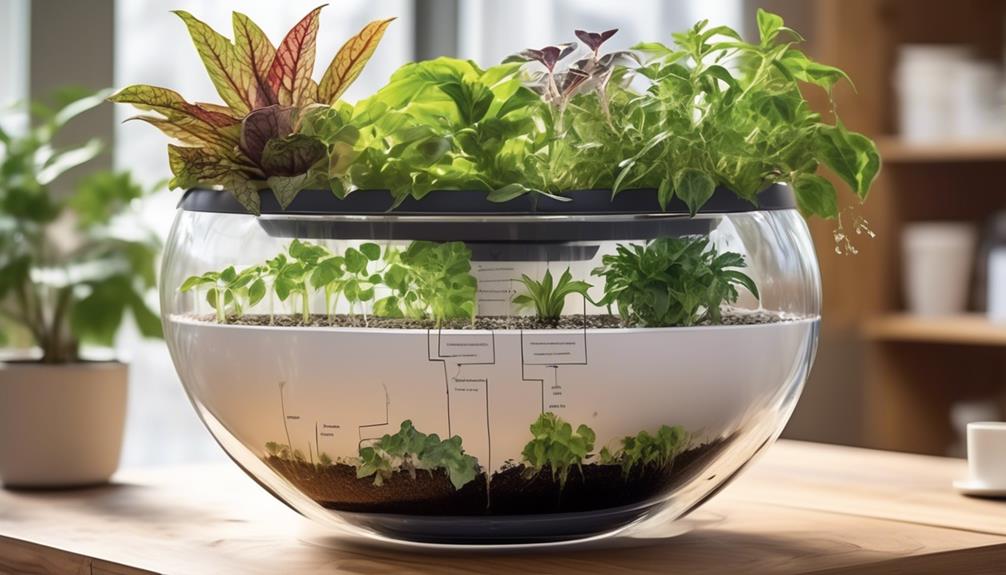
We have observed that the watering mechanism in self-watering planter pots is a common concern for many plant enthusiasts.
To address this, we've developed a system that allows for the regulation of water flow, ensuring optimal moisture levels for the plants.
Additionally, our design prevents overwatering by incorporating a reservoir that collects excess water, thus protecting the root system from potential damage.
Watering Mechanism
The self-watering planter pots utilize a capillary action system to efficiently and effectively deliver water to the plant's roots. This mechanism ensures that the plant receives water as needed, addressing concerns related to watering frequency and evaporation prevention.
- Watering Frequency: The capillary action allows the plant to draw water from the reservoir as needed, ensuring a consistent supply without overwatering. This helps to maintain optimal soil moisture levels and prevents under or overwatering, addressing concerns about the frequency of watering.
- Evaporation Prevention: By utilizing a reservoir system, the self-watering planter pots minimize water exposure to the surrounding environment, reducing evaporation. This helps to conserve water and ensures that the plant receives a consistent water supply, addressing concerns about water loss due to evaporation.
- Even Water Distribution: The capillary wick or similar system ensures that water is evenly distributed throughout the soil, providing consistent moisture levels for the plant's roots.
Preventing Overwatering
To prevent overwatering, the self-watering planter pots employ a capillary action system that allows the plant to draw water from the reservoir only as needed, ensuring optimal soil moisture levels and avoiding waterlogging. This capillary action is facilitated by the use of a wicking mechanism, such as a string or fabric, which extends from the reservoir into the soil.
When the soil becomes dry, it creates a negative pressure, causing water to be wicked up from the reservoir into the soil, maintaining a consistent level of moisture. Additionally, proper drainage techniques, such as having drainage holes at the bottom of the planter, ensure that excess water can escape, preventing water from accumulating and causing root rot.
Tips for Successful Plant Care
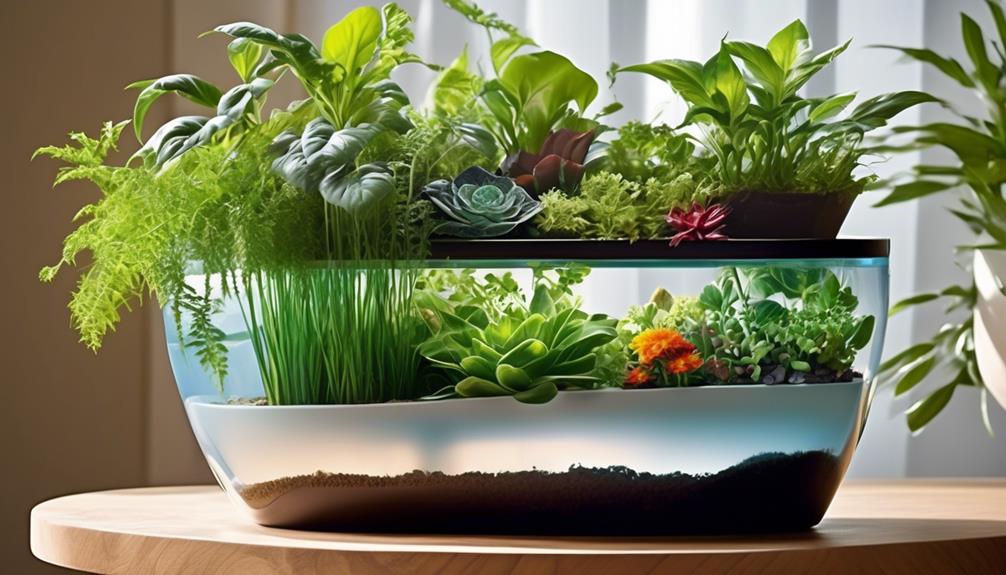
Regularly monitor the moisture levels in the soil to ensure optimal hydration for your plants. This is crucial for successful plant care.
Here are some key tips for maintaining healthy plants in self-watering planter pots:
- Plant Placement and Watering:
- Ensure proper plant placement within the planter to optimize water distribution.
- Consider the specific water needs of each plant species and adjust the watering frequency accordingly.
- Be mindful of the plant's growth stage, as it can affect its water requirements.
- Soil Moisture and Sunlight Exposure:
- Use a soil moisture meter to accurately gauge the moisture levels in the soil.
- Adjust the planter's sunlight exposure based on the plant's preferences and requirements.
- Monitor the surrounding environmental conditions to maintain an ideal microclimate for the plants.
- Nutrient Management and Pruning:
- Consider the nutrient requirements of your plants and supplement the soil as needed.
- Regularly inspect and prune the plants to promote healthy growth and prevent overgrowth.
Frequently Asked Questions
Are Self-Watering Pots Suitable for All Types of Plants?
Self-watering pots are suitable for a variety of plants, but plant compatibility is key. Different plants have varying water needs, so it's essential to match them with the right self-watering system.
Understanding the watering frequency for each plant is crucial. Some plants, like succulents, require less water and may not thrive in self-watering pots designed for high water retention.
It's important to research the specific needs of your plants before choosing self-watering pots.
Can Self-Watering Pots Be Used Outdoors as Well as Indoors?
Yes, self-watering pots can be used outdoors as well as indoors. Outdoor usage is possible due to their long-term durability. The design allows for consistent moisture levels, reducing the frequency of watering.
The reservoir system prevents overwatering, making them suitable for a wide range of plants. The pots' material and construction ensure they can withstand outdoor conditions, making them a reliable choice for outdoor gardening.
How Often Do I Need to Refill the Water Reservoir in a Self-Watering Pot?
We typically refill the water reservoir in our self-watering pot every 1-2 weeks, depending on the plant's hydration needs and the reservoir size.
Monitoring soil moisture is essential to determine the watering frequency.
The reservoir size directly impacts the duration between refills.
It's crucial to maintain an adequate water level to ensure consistent and optimal plant hydration.
Regularly checking the reservoir and soil moisture is key to successful self-watering pot maintenance.
Are There Any Specific Maintenance Requirements for Self-Watering Pots?
We understand the concern over maintenance, but self-watering pots are designed to minimize upkeep. Regular cleaning ensures optimal water flow and prevents mold growth. Use a mild soap solution to clean the reservoir and a bleach solution for stubborn stains.
Fertilizer requirements are reduced due to the consistent moisture levels, but it's still essential to periodically replenish the soil with nutrients. This simple cleaning process and minimal fertilizer needs make self-watering pots low-maintenance options.
Can Self-Watering Pots Help Prevent Overwatering of Plants?
Self-watering pots can be beneficial in preventing overwatering by providing a reservoir for plants to draw water from as needed. This can help maintain optimal soil moisture levels and reduce the risk of root rot. However, there are some limitations to consider, such as the potential for the reservoir to become stagnant and the need to monitor water levels regularly.
Understanding the effectiveness and drawbacks of self-watering pots is crucial for successful plant care.
What are the Benefits of Using Self-Watering Planter Pots?
Self-watering pots explanation: Self-watering planter pots offer several benefits, such as reducing the time and effort needed for plant care, preventing overwatering, and ensuring consistent moisture levels for healthy plant growth. These pots are ideal for busy individuals or frequent travelers who want to maintain a thriving indoor or outdoor garden with minimal maintenance.
Conclusion
In conclusion, self-watering pots offer a convenient and efficient way to keep your plants hydrated. With a wicking system and water reservoir, these pots provide a consistent water supply to the roots, reducing the frequency of manual watering.
Like a well-oiled machine, the self-watering pot ensures that your plants receive the moisture they need to thrive, making it a valuable tool for any gardener.
So, give it a try and watch your plants flourish with minimal effort.

